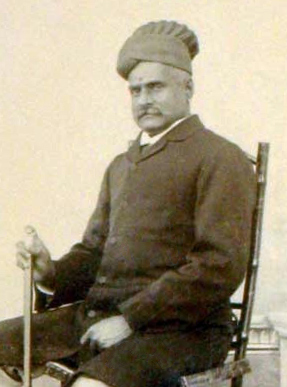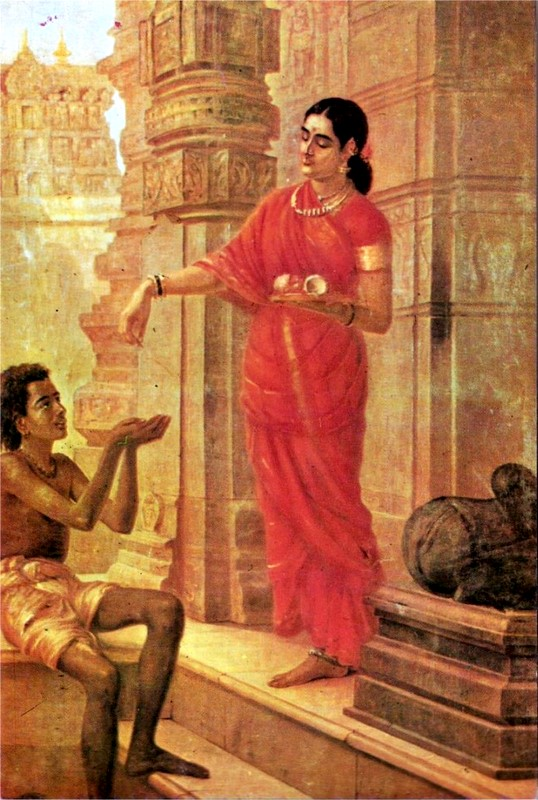A Quick Look Into The Timeless Beauty of Raja Ravi Varma's Artworks
- Pratha

- Jul 17
- 5 min read
In the kaleidoscope of art history, certain painters emerge as luminaries, leaving an indelible mark on the canvas of human creativity. Raja Ravi Varma, an eminent Indian artist from the late 19th and early 20th centuries, stands as one such figure whose paintings continue to captivate and enchant viewers with their exquisite blend of classical aesthetics and innovative techniques. Let’s delve into the life and works of Raja Ravi Varma, exploring the profound impact of his art on the cultural landscape of India and beyond.
Raja Ravi Varma's Background

Raja Ravi Varma was born on April 29, 1848, in Kilimanoor, a small princely state in present-day Kerala. His early exposure to the royal court and access to European art books laid the foundation for his unique style, which seamlessly fused Indian classical traditions with Western realism. Ravi Varma's passion for art was evident as early as the age of six when he began drawing with charcoal on the walls of the Kilimanoor palace and temple. His maternal uncle took Ravi Varma under his wing and taught him everything about art, while his father taught him Sanskrit poetry and literature.
At the age of 14, Ravi Varma headed for the Trivandrum palace with his uncle to demonstrate his ability in front of Maharaja Ayilyam Thirunal, the Travancore ruler at the time. Then onward, he lived in Travancore Palace and only visited Kilimanoor Palace for significant occasions and events. Trained initially under Rama Swami Naidu and later in the atelier of Theodore Jensen, a Dutch portrait painter, Ravi Varma's journey to artistic excellence was marked by a thirst for innovation and a deep reverence for the rich cultural heritage of India.
The Artistic Revolution:
Raja Ravi Varma is often credited with revolutionizing Indian art by introducing a novel approach to the portrayal of mythological and historical subjects. His breakthrough came with the lithographic series on the Indian epic, the Ramayana, in the late 19th century. The meticulously crafted lithographs brought Hindu deities and mythological characters to life, creating a visual language that resonated with the masses and bridged the gap between the elite and the common man.
Ravi Varma's technical mastery and attention to detail were evident in his ability to infuse emotion into his subjects. His paintings, characterized by vibrant colors, realistic depictions, and meticulous detailing, breathed new life into classical Indian themes. The use of chiaroscuro and a deep understanding of anatomy allowed him to create works that exuded a sense of realism while retaining the mythical charm intrinsic to Indian art.
Ravi Varma also sent some of his paintings to Europe to be oleographed in response to frequent requests for copies. Raja Varma even hired Fritz Schleicher, a German manufacturer, to assist in setting up the Ravi Varma Fine Art Lithographic Press in Girgaum, Bombay. The first chromolithograph, 'Birth of Shakuntala', was released in July 1894. This provided fresh significance and identity to Ravi Varma's works. His printed copies of Gods and Goddesses were widely distributed. It allowed people of various castes and creeds to worship their gods in their own homes, which was not possible in lower-caste houses at the time.
The Iconic Women of Raja Ravi Varma:
One of the defining aspects of Raja Ravi Varma's oeuvre is his portrayal of women. His paintings often featured ethereal female figures draped in rich silks and adorned with intricate jewelry, embodying the idealized beauty of the time. Mythological characters like Shakuntala, Damayanti, and Sita, as well as celestial beings like Saraswati and Lakshmi, graced his canvases, leaving an indelible mark on the collective imagination.
Ravi Varma's women were not mere subjects but powerful embodiments of grace, strength, and emotion. Their expressive faces and the subtle nuances of their body language conveyed a narrative that resonated with the viewers, transcending the boundaries of time and culture. The artist's ability to capture the essence of feminine beauty within the cultural context of India earned him widespread acclaim and admiration.
Some Famous Artworks of Raja Ravi Varma

1. Damayanti talking to a Swan:
In this enchanting masterpiece, Raja Ravi Varma captures the mythical moment of Damayanti conversing with a swan. The artist skillfully renders Damayanti's ethereal beauty as she engages in a dialogue with the swan, conveying the narrative from the Mahabharata. The intricate details of Damayanti's attire and the graceful posture of the swan exemplify Ravi Varma's ability to infuse life into classical Indian mythology.

2. Draupadi being humiliated in the court of Virata:
Ravi Varma's depiction of Draupadi's humiliation in the court of Virata is a poignant portrayal of a pivotal moment in the Mahabharata. The painting vividly captures Draupadi's vulnerability and the tension in the court as she undergoes the ordeal. The artist's use of color and composition amplifies the emotional impact, making the viewer a silent witness to the injustice suffered by Draupadi.
3. Galaxy of Musicians:
In "Galaxy of Musicians," Ravi Varma creates a vibrant tableau of classical Indian musicians, harmoniously united in their artistic pursuit. The artist's attention to detail is evident in the depiction of each musician's instrument and attire. The painting serves as a celebration of India's rich musical heritage, with Ravi Varma skillfully conveying the essence of each musician's contribution to the collective symphony.

4. Arjuna and Subhadra:
Ravi Varma's rendering of Arjuna and Subhadra from the Mahabharata captures a moment of love and tenderness. The painting radiates with the romantic aura surrounding the divine couple. The artist's use of color and composition not only highlights their celestial nature but also conveys the emotional connection between Arjuna and Subhadra.
5. Shakuntala:
Ravi Varma's portrayal of Shakuntala epitomizes the artist's ability to blend traditional Indian aesthetics with a touch of realism. Shakuntala, the central figure from the Sanskrit play "Abhijnanasakuntalam," is depicted with grace and elegance. The intricate detailing of her attire and the lush surroundings emphasize the timeless beauty of this iconic character.

6. Jatayu mauled by Ravana:
This dramatic scene from the Ramayana is brought to life by Raja Ravi Varma's adept brushstrokes. The painting captures the intensity of the moment as the virtuous vulture Jatayu valiantly confronts the demon king Ravana. Varma's dynamic composition and meticulous attention to anatomical details convey the ferocity of the battle, leaving an indelible impression on the viewer.

7. Lady giving alms in a temple:
In this poignant portrayal, Ravi Varma captures a moment of piety and compassion as a lady bestows alms in a temple. The artist skillfully communicates the solemnity of the scene, with the temple's architecture and the woman's gestures conveying a sense of spiritual devotion. The play of light adds a spiritual aura to the composition, highlighting the act of generosity.

8. Shakuntala Composing a Love Letter to King Dushyanta:
Ravi Varma's interpretation of Shakuntala composing a love letter is a testament to the artist's ability to convey emotion through visual storytelling. The painting beautifully captures Shakuntala's introspection and the delicate atmosphere as she writes to King Dushyanta. The subtle use of color and the meticulous detailing of Shakuntala's expression make this artwork a captivating exploration of love and longing.
Raja Ravi Varma's paintings are not mere artifacts; they are portals to a bygone era, reflecting the synthesis of tradition and innovation. His ability to capture the essence of India's cultural and mythological heritage with a brushstroke of modernity has left an enduring imprint on the world of art. As we gaze upon his masterpieces, we are transported to a realm where time stands still, and the beauty of Raja Ravi Varma's vision continues to resonate with the soul.
Author
Pratha Editorial Team








Comments